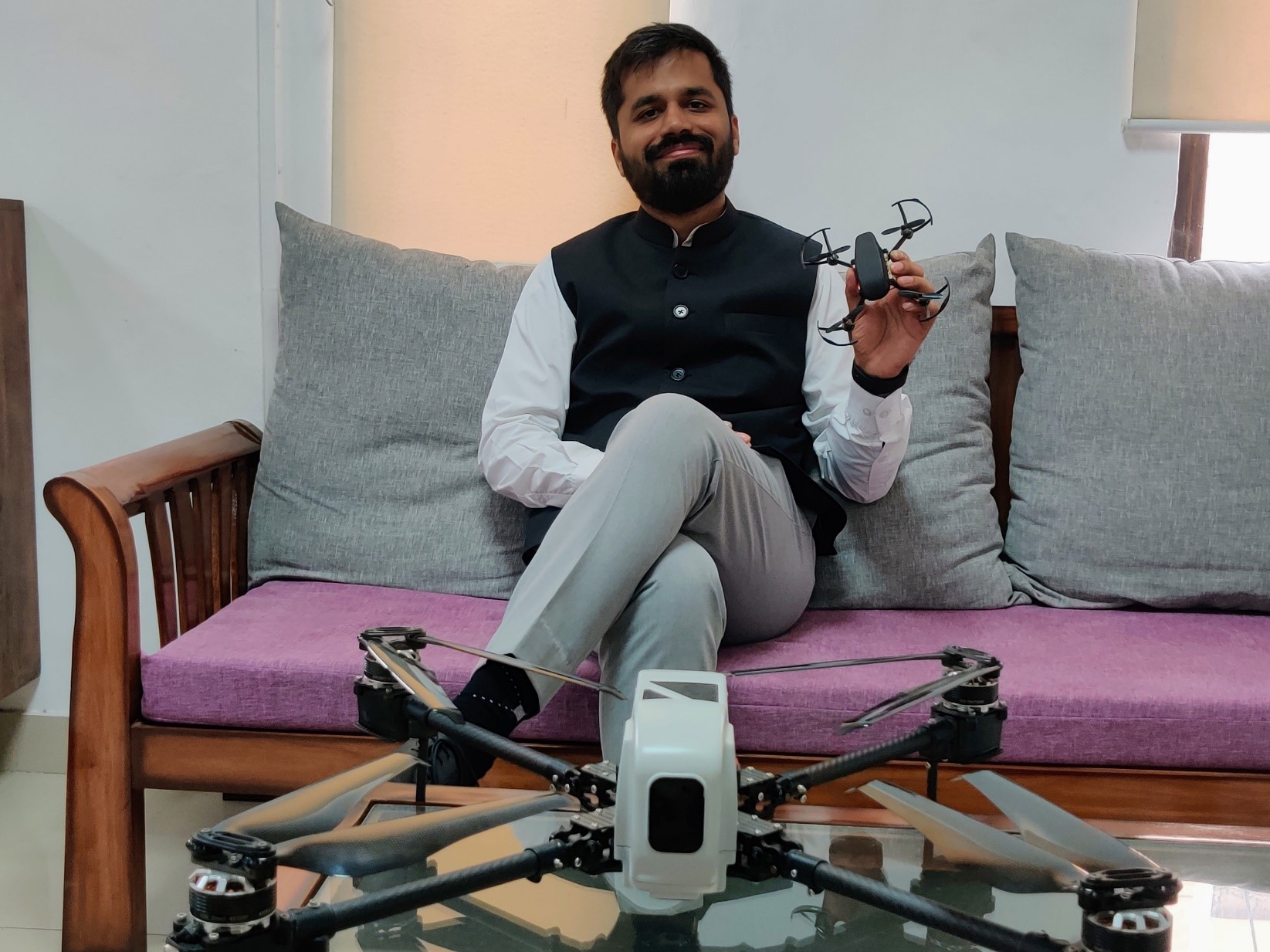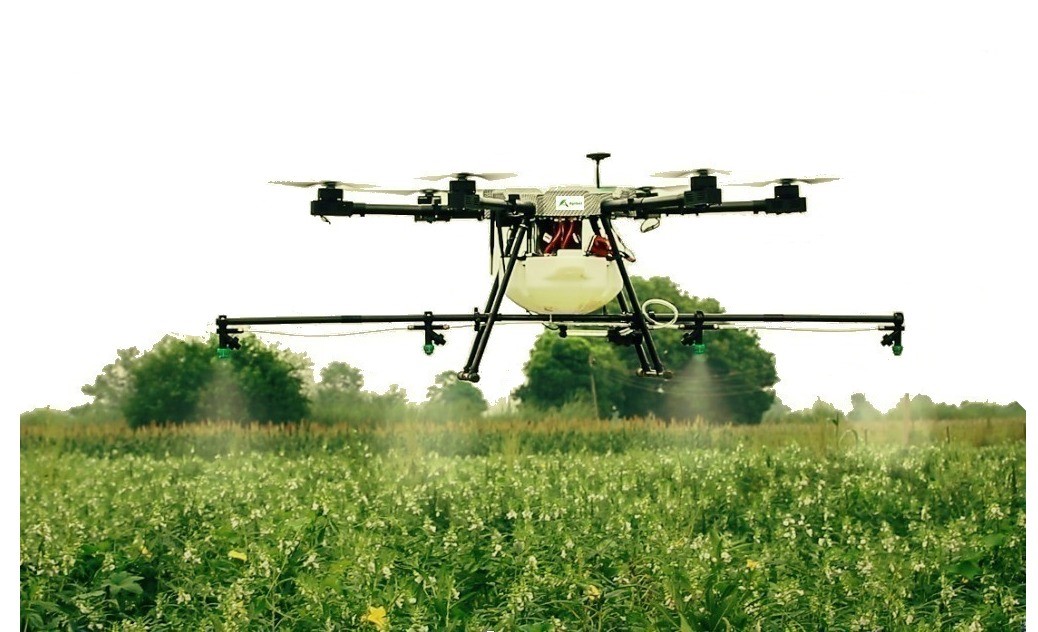
- A+
- A
- A-
Accelerating the Growth of the Indian Drone Ecosystem: An Interview with Smit Shah
The Drone Federation of India (DFI) is a non-governmental, not-for-profit, industry-led body formed to accelerate the growth of the drone ecosystem and make India a global drone manufacturing hub. DFI works with over 200 drone companies and 2000 drone pilots in five focus areas: policy advocacy, trade promotion, skill development, standards, and certification, all of which are executed using a ‘community driven approach’. Any individual or organisation engaged in drone manufacturing, designing, training, service provision, or software development can become a member of DFI. In this special issue of Vigyan Dhara, we speak to Smit Shah, the man leading the organization.

Smit Shah at his office, showcasing some of the drones that have landed on his desk.
Image credit: Drone Federation of India
The drone ecosystem in India is at a turning point and there is no better time than now to join the drone industry. The drone ecosystem is probably going to be at least equal, if not more game-changing than the IT revolution. Smit Shah explains why: “We have the best drone policy, best financial incentives and the best import policy. It is an opportunity not to be missed.”
The Mission to Change Drone Regulations in India
In 2014, the Directorate General of Civil Aviation (DGCA) imposed a blanket ban on the civilian use of drones (photographers, weddings, and film industry, etc.) severely restricting their use. In response, DFI advocated for regularising and legalising the use of drones in the country. Drones were legalised again in 2018, with the National Drone Policy, but with graded restrictions on manufacturing and operation, and strict compliance requirements. Further, each drone needed to be registered with a Unique Identity Number (UIN) with the DGCA. Getting involved in drone manufacturing, selling, and operations meant undertaking extensive paperwork including applying for multiple licenses, complex procedural requirements, and numerous permissions.
All of this changed with the new ‘Drone Rules 2021’ introduced in August 2021. Many restrictions were lifted, and the number of permissions or licences needed reduced from 25 to just five. Speaking of how the 2021 rules came about, Shah says, “I am proud to mention that DFI has played an active role in policy advocacy by representing the industry’s views and perspectives to government stakeholders to ensure a regulatory ecosystem that enables the industry’s growth while keeping the mandate of safety and security.”
Security forces had their concerns on the negative impact that the technology might have. But Shah reassures, “We had sensitization programmes, workshops, and technology demonstrations in the strategic defence sector, and also on the potential of this technology in agriculture, disaster management, and healthcare delivery. We put in multiple efforts in sensitizing the stakeholders in the central and state governments, and defence forces, on the multiple benefits that drone technologies can bring about and how these outweigh the very rare possibility of drone technology being misused. We were able to bring about a change in the way this technology and its applications were viewed.”
Now, in 2022, the sky looks clear for a drone ecosystem to soar high, with no permissions needed for research and development in the drone space, and only one key requirement for manufacturing drones—‘Type’ certification. Every drone still must have a UIN and pilots must have a ‘Remote Pilot Certificate’ from a remote pilot training school. “This is similar to driving a registered car with a driver’s licence,” Shah explains.
Drones in Industry 4.0
“The drone industry is a representation of how industry 4.0 can evolve to the next era with the use and deployment of automated unmanned vehicles,” Shah says. He believes that automation will first be realised in the air as there are no road-related complexities to manage.
“One success story is the agriculture sector,” says Shah. “DFI used a community-driven approach wherein drone manufacturers, service providers, pilots, and pesticide companies conducted sensitization programs for farmer producer organisations (FPOs) and Krishi Vigyan Kendras (KVKs). This resulted in a provision of 100% subsidy for government affiliated institutes, KVKs, and agricultural universities on an expenditure of up to ₹10 lakhs for buying drones. FPOs and rural local entrepreneurs can buy a drone with 75% and 40% subsidy, respectively,” he explains.
Similarly, pesticide rules were a barrier to the usage of drones in agriculture. DFI worked with multiple technical committees and pesticide companies, the Indian Agricultural Research Institute (IARI), Indian Council of Agricultural Research (ICAR), and the drone industry to facilitate studies to solve this challenge. As a result, the spraying of more than 400 different types of pesticides and other chemicals has been approved by the Ministry of Agriculture for collecting data, based on which full approval can be obtained after two years.
Drones can be used for basic industrial security surveillance, pipeline monitoring, land surveys, and applications in disaster situations like floods and earthquakes. Cargo logistics can also use drones effectively. For example, the delivery of vaccines and critical medicines in areas of the northern Himalayas, Leh Ladakh, and the northeast, where it takes over 4 hours for essential services to reach, will transform with the use of drones. Shah says, “We have conducted pilot projects with ICMR to showcase this technology—the government will create hubs and centralize the storage, management, and delivery of critical medicines to be delivered anywhere around a 150 km area on a notice of one phone call within 30–60 mins.”
Shah further explains, “We are expecting about 2–3 lakhs jobs to be created in the drone industry for the youth.” They can enter the drone ecosystem in three broad areas:
1) Design manufacturing: The youth can pursue airplane manufacturing, design, electronics assembly, system integration, programming, etc. Universities and colleges are teaching courses that can help the youth secure good jobs in leading drone companies.
2) Drone operations: The youth can become involved in giving different kinds of demos and trainings; operating drones is a huge requirement in the drone ecosystem. Any person who has graduated class 10 and is 18 years of age can get trained at a DGCA-approved drone training school. Shah explains, “A five-day course can get one a decent-paying sophisticated job compared to the blue-collar jobs normally available for this age and education.”
3) Data analysis: The youth can work to develop data processing and data analytics software to capture, manage, and analyse the data collected by drones.
Indeed, a drone revolution is brewing, and perhaps, a world in which you fly to your workplace or get food from your balcony could be a mere few years away.
 A Drone spraying pesticides on crops.
A Drone spraying pesticides on crops.
Image credit: Smit Shah
Adita Joshi is a science education and communication consultant, and a freelance science writer.




